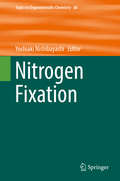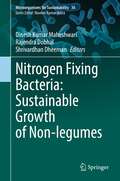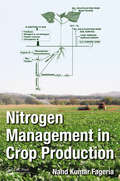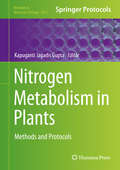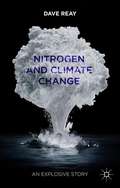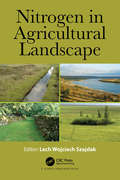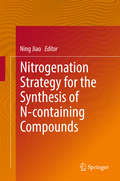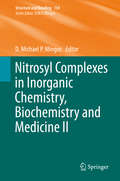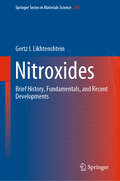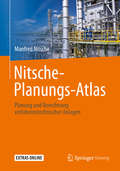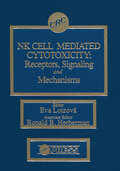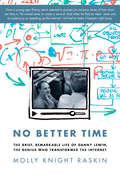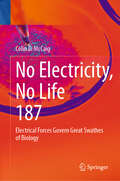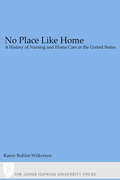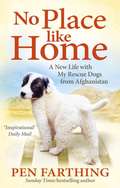- Table View
- List View
Nitrogen Fixation
by Yoshiaki NishibayashiThis volume presents a review of recent developments in nitrogen fixation using transition metal-dinitrogen complexes in the last decade. The authors are international experts in the corresponding field and each chapter discusses their latest achievements in the preparation of various transition metal-dinitrogen complexes and their reactivity. This volume will be helpful to researchers, teachers, and students who are interested in innovative and sustainable chemistry.
Nitrogen Fixing Bacteria: Sustainable Growth of Non-legumes (Microorganisms for Sustainability #36)
by Dinesh Kumar Maheshwari Shrivardhan Dheeman Rajendra DobhalThis book covers aspects of biological nitrogen fixation along with the unique signaling and interaction between the diazotrophic bacteria and plants, especially the non-legumes. Nitrogen is the most important growth-limiting nutrient in the ecosystems and biological nitrogen fixation involving microbial symbionts, mainly rhizobia and legumes holds enormous interest across the globe. However, free-living rhizobacteria of non-legumes especially cereals, also establish themselves within the root system, fixing nitrogen and contributing to plant productivity, soil fertility, and agricultural sustainability. These non-symbiotic nitrogen fixers additionally exhibit various plant growth-promoting traits elevating productivity, fortifying nutrient content, and managing water stress in plants. The recent perspectives highlighting the mechanisms and background of non-symbiotic nitrogen fixation provide answers to unravel the potential of nitrogenase and various spectra of habitats of rhizobia and other diazotrophic bacteria. Further, the application of genetic engineering and the development of nitrogen-fixing cereals can provide a possible solution to the problem of food shortage. The book includes various scientific inputs providing comprehensive knowledge about the emergence of agricultural sustainability through nitrogen-fixing bacteria. The book illustrates the systematic mechanisms involved in biological nitrogen fixation through various illustrations, schematic drawings, and flow charts aiding in better understanding. The chapters elaborate on the physiology and metabolism of plant-bacteria interaction in different crops under diverse environmental conditions. Thus, the volume will provide a holistic scenario helping in advancing the novel plant-microbe interactions, cell-signaling, and plant-molecular interactions. The book will assist the agronomists, microbiologists, ecologists, plant pathologists, molecular biologists, environmentalists, policymakers, conservationists, and NGOs to develop biofertilizers and bioinoculants using various genera of microbes and contribute to the targets of sustainable goals in an eco-friendly manner.
Nitrogen Management in Crop Production
by Nand Kumar FageriaOne of the main approaches for safeguarding food security, sustainable development has increased demand for knowledge on fertilizer management in crop production. Among essential plant nutrients, nitrogen is one of the most important yield-limiting nutrients, mainly responsible for determining yield and yield components in cereals and legumes. It i
Nitrogen Metabolism in Plants: Methods and Protocols (Methods in Molecular Biology #2057)
by Kapuganti Jagadis GuptaThis volume explores several different aspects of nitrogen metabolism, ranging from nitrogen uptake to assimilation. The chapters in this book cover topics such as measurement of activities of enzymes involved in nitrogen metabolism (i.e., nitrate reductase); measurement of nitric oxide, nitrite and ways to detect the N content in plants and microbes; characterization of root nodule bacteria (RNB); and techniques to perform proteomics of Extracellular Matrix (ECM). Written in the highly successful Methods in Molecular Biology series format, chapters include introductions to their respective topics, lists of the necessary materials and reagents, step-by-step, readily reproducible laboratory protocols, and tips on troubleshooting and avoiding known pitfalls.Thorough and cutting-edge, Nitrogen Metabolism in Plants: Methods and Protocols is a valuable tool for novice and expert researchers who are interested in learning more about this evolving field.
Nitrogen Removal Characteristics of Aerobic Denitrifying Bacteria and Their Applications in Nitrogen Oxides Emission Mitigation (Springer Theses)
by Maosheng ZhengThis book systematically investigates the nitrogen removal characteristics of two screened aerobic denitrifying bacteria and their applications in nitrogen oxides emissions reduction. It reveals that Pseudomonas stutzeri PCN-1 possesses excellent capacity for aerobic nitrogen removal, regardless of whether nitrate, nitrite or N2O were taken as denitrification substrates. It also demonstrates that the rapid N2O reduction is due to the coordinate expression of denitrification genes. Further, the book discusses the bioaugmentation experiments conducted in denitrifying SBR and a pilot-scale Carrousel oxidation ditch, which confirmed that the strain could significantly enhance denitrification performance, reduce N2O emission and improve system stability. The second strain, P.aeruginosa PCN-2 accumulated negligible NO during aerobic nitrate and nitrite removal and efficiently removed NO from flue gas. This study is of great significance for potential applications of aerobic denitrification in mitigating nitrogen oxides emissions from biological nitrogen removal systems.
Nitrogen and Climate Change
by Dave ReayIt is the perfect storm. Limited food, water and energy unequally spread between an expanding population, and a warming climate as the bitter icing on the cake. In all these global challenges nitrogen has a leading role to play. In Nitrogen and Climate Change, Dave Reay looks at just how hard-wired into all of human civilisation nitrogen is, and whether the future will see it as our quiet savior or the toxic villain of the piece. Its story is of the peculiar and the mundane, of water turning red and people turning blue. It is one of climate friend and pollution foe, of meaty feasts and looming famine. If your main thought of nitrogen is as a boring corner of the periodic table, then it is time to look again.
Nitrogen in Agricultural Landscape
by Lech Wojciech SzajdakAgriculture transforms the environment. The simplification of agroecosystems structure increases the hazards of leaching, wind and water erosion, and volatilization of chemicals from soil. Soil nitrogen is of interest as a major crop nutrient, but also as a potential environmental pollutant. Knowledge about the behavior of soil nitrogen is desirable in order to optimize plant growth and crop yield and to minimize environmental side effects. This book also gives information about the function of biogeochemical barriers in the form of shelterbelts, which efficiently decrease the concentrations of various forms of nitrogen in ground water.
Nitrogen-Rich Energetic Materials
by Michael Gozin Leonid L. FershtatNitrogen-Rich Energetic Materials Provides in-depth and comprehensive knowledge on both the chemistry and practical applications of nitrogen-rich energetic materials Energetic materials, a class of material with high amounts of stored chemical energy, include explosives, pyrotechnics, and propellants. Initially used for military applications, nitrogen-rich energetic materials have become important in the civil engineering and aerospace sectors, they are increasingly used in commercial mining and construction as well as in rocket propulsion. Making these nitrogen-rich energetic materials safer, more powerful, and more cost-effective requires a thorough understanding of their chemistry, physics, synthesis, properties, and applications. Nitrogen-Rich Energetic Materials presents a detailed summary of the development of nitrogen-rich energetic materials over the past decade and provides up-to-date knowledge on their applications in various areas of advanced engineering. Edited by a panel of international experts in the field, this book examines the chemistry of pentazoles, fused ring and laser ignitable nitrogen-rich compounds, polynitrogen and tetrazole-based energetic compounds, and more. The text also introduces applications of nitrogen-rich energetic materials in energetic polymers and metal-organic frameworks, as pyrotechnics materials for light and smoke, and in oxadiazoles from precursor molecules. This authoritative volume: Presents in-depth chapters written by leading experts in each sub-field covered Offers a systematic introduction to new and emerging applications of nitrogen-rich energetic materials such as in computational chemistry Discusses recent advances in nitrate ester chemistry with focus on propellant applications Discusses green and eco-friendly approaches to nitrogen-rich compounds Nitrogen-Rich Energetic Materials is an important resource for researchers, academics, and industry professionals across fields, including explosives specialists, pyrotechnicians, materials scientists, polymer chemists, laser specialists, physical chemists, environmental chemists, chemical engineers, and safety officers.
Nitrogen-Rich Polycyclic-Based Energetic Materials
by Jie Tang Guangbin Cheng Hongwei YangThis book describes the design, synthesis, performance and practical application of energetic materials. The book consists of thirteen chapters demonstrating the design routes of nitrogen-rich polycyclic-based energetic materials that are bicyclic, tricyclic and tetracyclic-based. It presents the synthesis of the energetic backbone, the construction of linkage and the introduction of energetic units, which could have a positive impact on the chemistry of not only on high-energy-density materials but also in other fields. The book also provides detailed analysis of the experimental methods discussed. Work in this area will benefit from the combine expertise from organic, inorganic and physical chemistry as well as other connected disciplines. As such this book has wide appeal and will help in increasing fundamental knowledge of nitrogen-rich heterocycles to eventually allow for this knowledge to be transferred into industrial applications.
Nitrogenation Strategy for the Synthesis of N-containing Compounds
by Ning JiaoThis book focuses on direct nitrogenation strategies to incorporate one or more N-atoms into simple substrates especially hydrocarbons via C-H and/or C-C bond cleavage, which is a green and sustainable way to synthesize nitrogen-containing compounds. The book consists of seven chapters demonstrating interesting advances in the preparation of amines, amides, nitriles, carbamides, azides, and N-heterocyclic compounds and illustrating the mechanisms of these novel transformations. It offers an accessible introduction to nitrogenation reactions for chemists involved in N-compound synthesis and those interested in discovering new reagents and reactions. Ning Jiao is a Professor of Chemistry at Peking University, China.
Nitrosyl Complexes in Inorganic Chemistry, Biochemistry and Medicine I
by D. Michael P. MingosThe series Structure and Bonding publishes critical reviews on topics of research concerned with chemical structure and bonding. The scope of the series spans the entire Periodic Table and addresses structure and bonding issues associated with all of the elements. It also focuses attention on new and developing areas of modern structural and theoretical chemistry such as nanostructures, molecular electronics, designed molecular solids, surfaces, metal clusters and supramolecular structures. Physical and spectroscopic techniques used to determine, examine and model structures fall within the purview of Structure and Bonding to the extent that the focus is on the scientific results obtained and not on specialist information concerning the techniques themselves. Issues associated with the development of bonding models and generalizations that illuminate the reactivity pathways and rates of chemical processes are also relevant. The individual volumes in the series are thematic. The goal of each volume is to give the reader, whether at a university or in industry, a comprehensive overview of an area where new insights are emerging that are of interest to a larger scientific audience. Thus each review within the volume critically surveys one aspect of that topic and places it within the context of the volume as a whole. The most significant developments of the last 5 to 10 years should be presented using selected examples to illustrate the principles discussed. A description of the physical basis of the experimental techniques that have been used to provide the primary data may also be appropriate, if it has not been covered in detail elsewhere. The coverage need not be exhaustive in data, but should rather be conceptual, concentrating on the new principles being developed that will allow the reader, who is not a specialist in the area covered, to understand the data presented. Discussion of possible future research directions in the area is welcomed. Review articles for the individual volumes are invited by the volume editors. Readership: research scientists at universities or in industry, graduate students Special offer For all customers who have a standing order to the print version of Structure and Bonding, we offer free access to the electronic volumes of the Series published in the current year via SpringerLink.
Nitroxides: Brief History, Fundamentals, and Recent Developments (Springer Series in Materials Science #292)
by Gertz I. LikhtenshteinWritten by a pioneer in the development of spin labeling in biophysics, this expert book covers the fundamentals of nitroxide spin labeling through cutting-edge applications in chemistry, physics, materials science, molecular biology, and biomedicine. Nitroxides have earned their place as one of the most popular organic paramagnets due to their suitability as inhibitors of oxidative processes, as a means to polarize magnetic nuclei, and, in molecular biology, as probes and labels to understand molecular structures and dynamics AS DRAGS FOR CANCER AND OTHER DISEASES. Beginning with an overview of the basic methodology and nitroxides’ 145-year history, this book equips students with necessary background and techniques to undertake original research and industry work in this growing field.
Nitsche-Planungs-Atlas: Planung und Berechnung verfahrenstechnischer Anlagen
by Manfred NitscheDieses Fachbuch erläutert die Vorgehensweise beim Planen und Bauen einer verfahrenstechnischen Anlage. Eine verfahrenstechnische Planung besteht aus der Berechnung und Auslegung von Apparaten, Maschinen und Hilfsanlagen sowie der Organisation des Planungsablaufs. Aus diesem Grund werden in diesem Werk auch die verfahrenstechnischen Berechnungen sowie der organisatorische Ablauf in der Praxis behandelt - unter Berücksichtigung der jeweiligen Vorschriften in dem Land und ergänzt durch zahlreiche Beispiele. Ein Wärmetauscher, eine Kolonne oder ein Reaktor muss berechnet werden. Für die ausgelegten Apparate und Maschinen werden die Anfragen spezifiziert. Auch Rohrleitungen, Pumpen und Regelventile müssen ausgelegt werden. Hier ist Kreativität gefragt, Probleme müssen gelöst werden. Die Betriebsmittelversorgung muss sichergestellt sein. Auch die wirtschaftlichen Anforderungen müssen mit den physikalischen Gesetzen und den Vorschriften in den verschiedenen Ländern in Einklang gebracht werden.
Nk Cell Mediated Cytotoxicity: Receptors, Signaling, and Mechanisms
by Eva LotzovaThis volume provides a state-of-the-art survey of developments in the field of NK cell-cancer cell interactions, activation, and oncolytic signaling. Specific topics discussed include NK cell receptors and adhesion molecules, signal transduction and activation, and mechanisms of cytotoxicity. The book will be an excellent learning tool and reference resource for scientists, clinicians, and students.
No Better Time: The Brief, Remarkable Life of Danny Lewin, the Genius Who Transformed the Internet
by Molly Knight RaskinNo Better Time tells of a young, driven mathematical genius who wrote a set of algorithms that would create a faster, better Internet. It's the story of a beautiful friendship between a loud, irreverent student and his soft-spoken MIT professor, of a husband and father who spent years struggling to make ends meet only to become a billionaire almost overnight with the success of Akamai Technologies, the Internet content delivery network he cofounded with his mentor.Danny Lewin's brilliant but brief life is largely unknown because, until now, those closest to him have guarded their memories and quietly mourned their loss. For Lewin was almost certainly the first victim of 9/11, stabbed to death at age 31 while trying to overpower the terrorists who would eventually fly American Flight 11 into the World Trade Center. But ironically it was 9/11 that proved the ultimate test for Lewin's vision--while phone communication failed and web traffic surged as never before, the critical news and government sites that relied on Akamai--and the technology pioneered by Danny Lewin--remained up and running.
No Electricity, No Life: Electrical Forces Govern Great Swathes of Biology (Reviews of Physiology, Biochemistry and Pharmacology #187)
by Colin D. McCaigThis book presents the essential electrical events that shaped the creation of a planet that can support life, shaped membrane formation, single cell formation, single cell wound healing, multicellularity, epithelial tissues, basement membranes and many other biological events. This book aims to do three things: 1) enhance awareness of the lesser known contributions of electrical forces in life, 2) develop a picture of the all-embracing impact of electricity throughout biology and 3) as a consequence pave the way for new technologies that target these less well known electrical events. This book introduces a balanced and scientific thesis, that electrical forces are used ubiquitously throughout biology. It serves as a valuable resource for anyone interested in understanding the role of electricity in shaping life. The reader may also find how SARS-CoV-2 used electricity to infect humans and how we might tackle dementia.
No Limits: The Inside Story of China's War with the West
by Andrew SmallThe riveting and mostly untold story about the battle for financial and technological power and mastery between the West and China over the last decade.Since China joined the WTO in December 2001, the West has been developing ever closer business and political ties. China's hosting of the Olympcis Games and its economic leadership in 2008 as the world faced recession were signs that China's new power and wealth would herald greater global prosperity for all. But that era is over. What was the cause of this rupture, leading China expert Andrew Small asks and what does it mean for the future? Using his deep access to the leading players in the story, Small dramatizes the intense political battles over the introduction of 5G to show how China and the West have spilt and how those abstract geopolitical rivalries translate into our daily lives—the phones we all use, the hidden wiring of the economy, and who controls it. Written with extraordinary insider access, Small's story ranges from deep inside the bowels of the Pentagon to Indian Ocean naval bases, and from the boardrooms of the world&’s leading technology firms to the Taliban leadership in Kabul. The result is an engaging, lucid and even-handed account of the defining geopolitical issue of our age, and a clarion call for us to recognize the true nature of China&’s global ambitions.
No More Bedtime!
by Chuck RichardsA vibrantly illustrated picture book about an inventive boy who hates bedtime, so he decides to build a top-secret machine that would put an end to it once and for all!Elliot doesn't like bedtime. It always comes before he is finished with his day! He constantly creates new inventions to outwit his parents and stay up later—like the MEGA-BOOK 5000 and the PILLOW-COPTER 5000.Nothing works, until Elliot has a brainstorm. This flash of genius leads to the ultimate machine that can keep the sun from setting for as long as Elliot wants.But is a never-ending day as amazing as it has always seemed?
No Need for Geniuses: Revolutionary Science in the Age of the Guillotine
by Professor Steve JonesParis at the time of the French Revolution was the world capital of science. Its scholars laid the foundations of today's physics, chemistry and biology. They were true revolutionaries: agents of an upheaval both of understanding and of politics. Many had an astonishing breadth of talents. The Minister of Finance just before the upheaval did research on crystals and the spread of animal disease. After it, Paris's first mayor was an astronomer, the general who fought off invaders was a mathematician while Marat, a major figure in the Terror, saw himself as a leading physicist. Paris in the century around 1789 saw the first lightning conductor, the first flight, the first estimate of the speed of light and the invention of the tin can and the stethoscope. The metre replaced the yard and the theory of evolution came into being. The city was saturated in science and many of its monuments still are. The Eiffel Tower, built to celebrate the Revolution's centennial, saw the world's first wind-tunnel and first radio message, and first observation of cosmic rays.Perhaps the greatest Revolutionary scientist of all, Antoine Lavoisier, founded modern chemistry and physiology, transformed French farming, and much improved gunpowder manufacture. His political activities brought him a fortune, but in the end led to his execution. The judge who sentenced him - and many other researchers - claimed that 'the Revolution has no need for geniuses'. In this enthralling and timely book Steve Jones shows how wrong this was and takes a sideways look at Paris, its history, and its science, to give a dazzling new insight into the City of Light.
No Need for Geniuses: Revolutionary Science in the Age of the Guillotine
by Steve JonesParis at the time of the French Revolution was the world capital of science. Its scholars laid the foundations of today's physics, chemistry and biology. They were true revolutionaries: agents of an upheaval both of understanding and of politics. Many had an astonishing breadth of talents. The Minister of Finance just before the upheaval did research on crystals and the spread of animal disease. After it, Paris's first mayor was an astronomer, the general who fought off invaders was a mathematician while Marat, a major figure in the Terror, saw himself as a leading physicist. Paris in the century around 1789 saw the first lightning conductor, the first flight, the first estimate of the speed of light and the invention of the tin can and the stethoscope. The metre replaced the yard and the theory of evolution came into being. The city was saturated in science and many of its monuments still are. The Eiffel Tower, built to celebrate the Revolution's centennial, saw the world's first wind-tunnel and first radio message, and first observation of cosmic rays.Perhaps the greatest Revolutionary scientist of all, Antoine Lavoisier, founded modern chemistry and physiology, transformed French farming, and much improved gunpowder manufacture. His political activities brought him a fortune, but in the end led to his execution. The judge who sentenced him - and many other researchers - claimed that 'the Revolution has no need for geniuses'. In this enthralling and timely book Steve Jones shows how wrong this was and takes a sideways look at Paris, its history, and its science, to give a dazzling new insight into the City of Light.
No Ordinary Day
by Deborah EllisAfter learning that her family adopted her, Valli runs away from home to live on the streets of Kolkata, India, where she begs, steals, and resists help from a doctor who reveals that she has leprosy.
No Ordinary Man: George Mercer Dawson 1849-1901
by Lois Winslow-Spragge Bradley LocknerGeorge Mercer Dawson was indeed no ordinary man. Born in 1849, son of the first Principal of McGill University, Dawson defied health circumstances that would have defeated many people and went on to become one of our most exceptional Canadians. As a geologist in the British North American Boundary Commission between Canada and the U.S.A. and as Director of the Geological Survey of Canada in 1895, Dawson examined and explored every aspect of Canada’s unknown territories. This collection of writings, letters, diaries and essays begins with the young George and moves through his developing years to his adult life. "He climbed, walked and rode on horseback over more of Canada than any other member of the Geological Survey of Canada at that time – yet to look at him, one would not think him capable of a day’s hard physical labour …. It was his hand that first traced upon vacant maps the geological formations of the Yukon and much of British Columbia."- Lois Winslow-Spragge". To read about him is like taking a drink of water from a cool, unpolluted spring. His sense of values was so great that he once said he didn’t care much for money or possessions. All he wanted was what he could hold in his canoe."- Anne Byers, Ottawa
No Place Like Home: A History of Nursing and Home Care in the United States
by Karen Buhler-WilkersonWinner of the Lavinia Dock Award from the American Association for the History of NursingHonorable Mention for the Association of American Publishers Professional/Scholarly Publishing Awards in Nursing and Allied HeathNo Place Like Home sets out to determine why home care, despite its potential as a cost-effective alternative to institutional care, remains a marginalized experiment in care giving. Nurse and historian Karen Buhler-Wilkerson traces the history of home care from its nineteenth-century origins in organized visiting nurses' associations, through a time when professional home care nearly disappeared, on to the 1960s, when a new wave of home care gathered force as physicians, hospital managers, and policy makers responded to economic mandates. Buhler-Wilkerson links local ideas about the formation and function of home-based services to national events and health care agendas, and she gives special attention to care of the "dangerous" sick, particularly poor immigrants with infectious diseases, and the "uninteresting" sick—those with chronic illnesses.
No Place Like Home: A New Beginning with the Dogs of Afghanistan
by Pen FarthingMarley and Me meets Bravo Two Zero, in this sequel to One Dog at a Time: Saving the Strays of Afghanistan. Nowzad was a gentle giant when it came to taking treats. He never, ever snatched. To me it was just further evidence that, deep inside, there was a great dog struggling to find his way out. When Pen Farthing brings stray dogs Nowzad and Tali back from his tour of Afghanistan, little does he know what he has begun. Suddenly he has four dogs to look after—two of whom have never been housetrained. And soon he is inundated with requests from other Marines and soldiers to help bring their rescued dogs home. Whether it's little Helmand, Fubar, or Beardog, Pen does his utmost to give these dogs the chance they deserve. This is the story of one man's courage and persistence as he struggles to give his dogs at home, and those still in Afghanistan, the best possible chance. It will warm—and break—the hearts of dog lovers everywhere.
No Place for a War Baby: The Global Politics of Children born of Wartime Sexual Violence (Gender in a Global/Local World)
by Donna SetoDonna Seto investigates why children born of wartime sexual violence are rarely included in post-conflict processes of reconciliation and recovery. The focus on children born of wartime sexual violence questions the framework of understanding war and recognizes that certain individuals are often forgotten or neglected. This book considers how children are neglected sites for the reproduction of global norms. It approaches this topic through an interdisciplinary perspective that questions how silence surrounding the issue of wartime sexual violence has prevented justice for children born of war from being achieved. In considering this, Seto examines how the theories and practices of mainstream International Relations (IR) can silence the experiences of war rape survivors and children born of wartime sexual violence and explores the theoretical frameworks within IR and the institutional structures that uphold protection regimes for children and women.
